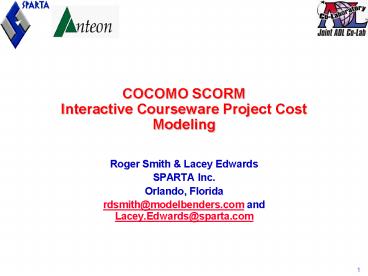COCOMO SCORM Interactive Courseware Project Cost Modeling - PowerPoint PPT Presentation
1 / 18
Title:
COCOMO SCORM Interactive Courseware Project Cost Modeling
Description:
COCOMO-SCORM Project: Proposed Solution ' ... Have currently collected data on 7 projects. Targeting 40 projects to calibrate the model appropriately ... – PowerPoint PPT presentation
Number of Views:134
Avg rating:3.0/5.0
Title: COCOMO SCORM Interactive Courseware Project Cost Modeling
1
COCOMO SCORMInteractive Courseware Project Cost
Modeling
- Roger Smith Lacey Edwards
- SPARTA Inc.
- Orlando, Florida
- rdsmith_at_modelbenders.com and Lacey.Edwards_at_sparta.
com
2
COCOMO-SCORM Project Proposed Solution
Proposed Technical Concept
Every complex project requires project managers
and sponsors to calculate the expected level of
effort, duration, and cost of the project.
Developing web-based content to the Sharable
Content Object Reference Model (SCORM) is complex
enough that an algorithm is necessary to assist
both the government and developers in estimating
the size of the project. SPARTA and Anteon
propose to create an interactive courseware
estimation tool based on widely used
Instructional Systems Design (ISD) methodologies
and on the principles contained in the
well-established and widely accepted COCOMO II
model for software project estimation.
COCOMO ISD
Interactive Courseware Estimation Tool
Development and Test Cost Estimates
3
Project Description
- Create an interactive project estimation tool for
ISD/SCORM content - Algorithmic foundation for the tool is the COCOMO
II algorithm developed for software projects by
the research team at the University of Southern
California and led by Barry Boehm - ISD methodology estimated will be the ADDIE model
developed at Florida State University and adopted
by the U.S. Armed Services - Resulting algorithm and tools will estimate the
person-months required to create a SCORM
conformant learning product - Dollar costs can be derived outside of the model
by applying industry or specific company labor
rates
4
COCOMO Model Family
Other Independent Estimation Models
Software Cost Models
DBA COCOMO 2004
COCOMO 81 1981
COCOTS 2000
COSYSMO 2002
COCOMO II 2000
COINCOMO 2004
COSoSIMO 2004
Costing Secure System 2004
iDAVE 2003
COPLIMO 2003
COPSEMO 1998
Security Extension 2004
COQUALMO 1998
COPROMO 1998
CORADMO 1999
Software Extensions
Legend Model has been calibrated with historical
project data and expert (Delphi) data Model is
derived from COCOMO II Model has been calibrated
with expert (Delphi) data
Dates indicate the time that the first paper was
published for the model
5
COCOMO II Tool Example
Users Perspective
6
COCOMO II Modeling Methodology
7
ADDIE Process
Job/Task Analysis Needs Analysis Learning Analys
is Situation Analysis Technical Analysis
Storyboards Programming Multimedia Testing
Trials Pilot tests
Design Plan Instructional Media Design
Report SCORM Plan
Reliability Validation Training Plan
8
COSCOMO Drivers(27 Input Variables)
- Size
- Source Lines of Code (SLOC)
- Design Modification (DM)
- Code Modification (CM)
- Integration (IM)
- Assessment (AA)
- Understanding (SU)
- Unfamiliarity (UNFAM)
- Scale Drivers
- Development Flexibility (FLEX)
- Process Maturity (PMAT)
- Precedentedness (PREC)
- Arch/Risk Resolution (RESL)
- Team Cohesion (TEAM)
- Product Effort Multipliers (EM)
- Required Reliability (RELY)
- Product Complexity (CPLX)
- Required Reuse (RUSE)
- Documentation (DOCU)
- Platform EM
- Platform Volatility (PVOL)
- Bandwidth (BAND)
- Personnel EM
- Senior Capability (SCAP)
- Developer Capability (DCAP)
- Personnel Continuity (PCON)
- Applications Experience (APEX)
- Platform Experience (PLEX)
- Development Tools Experience (DTEX)
- Project EM
- Lifecycle Tools (LIFE)
- Multisite Development (SITE)
- Required Development Schedule (SCED)
9
Quantitative Size Variables
10
EM Effect on Project
15 Effort Multipliers Set to Nominal
Course Hours
Project Cost
11
Qualitative Project Variables
Effort Multipliers
Scale Drivers
Nominal/Standard Levels
12
EM Effect on Project
15 Effort Multipliers Other Than Nominal
Est. Cost
Course Hours
Nom. Cost
13
Data Collection Form
(see Excel file for entire form)
14
COSCOMO Estimates
Survey was not completed. All remaining
variables were estimated.
15
Defense Nuclear Weapons School
16
Building PRED(30) for COSCOMO
Total Project Cost (PM)
DNWS -3.8
78
ALC 333
24
EHA -20
6
0
-30
30
Variance of Estimated Value
17
Reliability PRED(30)
- Reliability of COCOMO family of models is often
measured by the percentage of test cases that it
will estimate within 30 of the actual project
costs - e.g. If a project requires 300 person-months to
complete, then its PRED(30) range would be (210
to 390) - If the model estimates 70 of its test cases
within this range then the models PRED(30) 70 - COCOMO Family Model Levels
- COCOMO II PRED(30) 64
- COSYSMO PRED(30) 56
- COSCOMO PRED(30) unknown at this time
18
Delphi Calibration Survey
- Using Delphi Method to gather independent
opinions about the level of effort associated
with each setting on each variable. - Collect individual responses
- Calculate group average
- Present averages to each person and allow them to
change their responses if they would like - Convene group work session to settle on
acceptable values - Round 1 of Delphi Conducted Via Private Survey
- Round 2 Conducted in Seminar Form
19
Conclusion
- COCOMO II has been modified to include variables
that are important to SCORM courseware developers - Variable weights are being adjusted by Delphi
surveys of experts - Model is being calibrated through the collection
of historical project information - Current results show that this approach is
feasible - It is to early to determine the degree of success
that will be achieved - Historical project data collection is essential,
but it is also very difficult to get access and
cooperation from the people with this information
- Have currently collected data on 7 projects
- Targeting 40 projects to calibrate the model
appropriately































